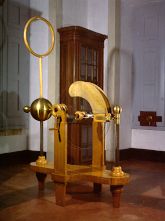
290 x 135 x 200
Glass, brass, felt and wood
CAT. 1878 : 370
Grande machina electrica dupla de Le Roy.
An electrical machine similar to the previous one, but whose glass sphere is more electrical.
This model of an electrostatic machine has some additional features in relation to the first machines built by Le Roy in the 18th century. It comprises two glass discs, one metre in diameter, that are turned in unison on a common horizontal axis by handles on either end of that axis.
A pair of felt pads on either side of each disc is rubbed as they rotate. These pads are in electrical contact with a brass sphere, 14 cm in diameter, which gains a negative charge from the friction. The sphere is mounted on a cylindrical glass rod which keeps it electrically isolated.
Diametrically opposed to the pads are four wooden rings, 25 cm in diameter, arranged on each side of the glass discs. These rings have 17 sharp spikes distributed on two concentric arcs. The spikes collect the electric charge from the disc. The charge is transferred to a brass sphere, 40 cm in diameter, by means of a conductor, also made of brass. This sphere has two smaller ones attached to it, one measures 14 cm and the other 3,5 cm in diameter.
The metal spikes on the wooden rings, mentioned above, gain a dense negative charge by induction. The positive charge on the glass and the negative one on the spikes produces an electrical discharge between them, which can be seen in a dark room. This discharge results in an accumulation of a positive charge on the spheres, which are electrically connected to the metal base of the collecting rings.
Although the machine was only acquired by the Gabinete de Física in 1873, it is a fine example of the type of electrostatic machine which was devised by Le Roy a hundred years before.
Daguin, Pierre-Adolphe, Traité Élémentaire de Physique Théorique et Expérimentale, Paris, 1878, n.º 1604.